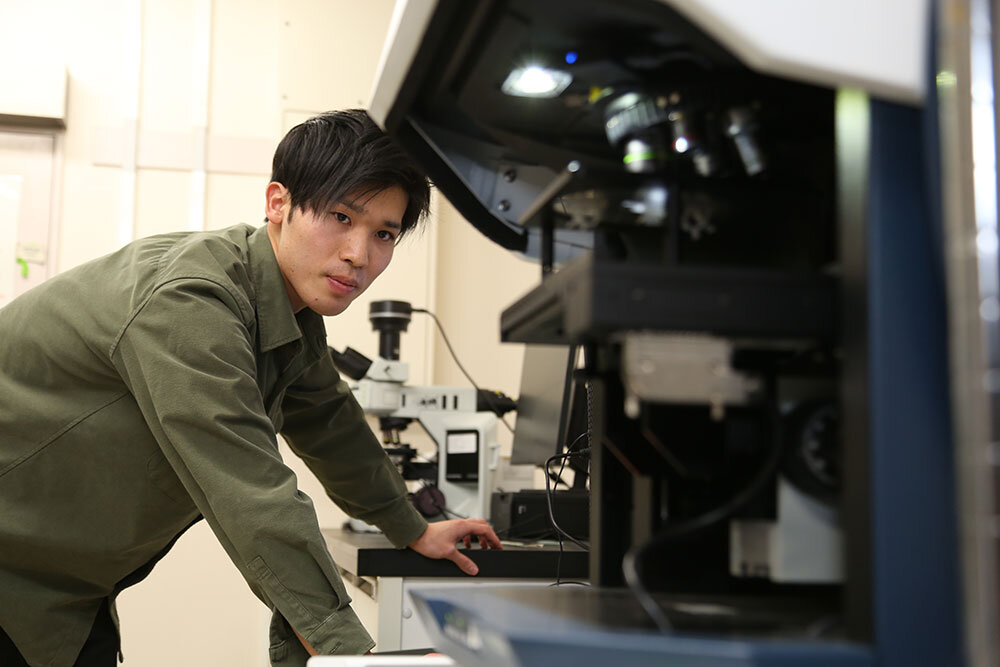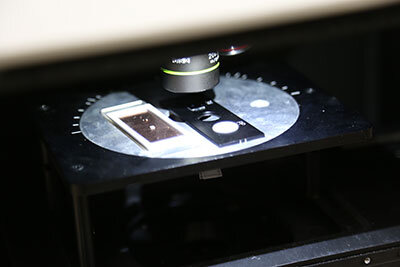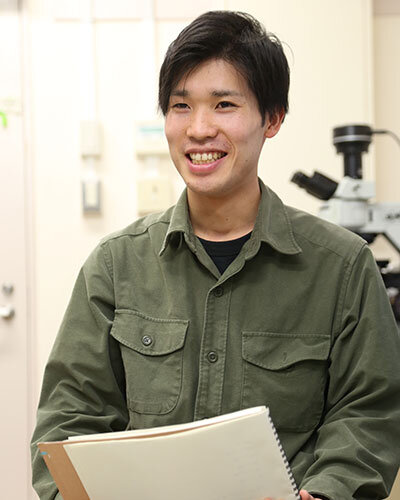INTRODUCTION学生紹介
- HOME
- support
- Student Introduction
- NAGASHIMA HIROYA
STUDENT INTRODUCTION
Marine Resources and Environment
NAGASHIMA HIROYA
Specializations:Ocean Sciences
Main academic advisor:ARAKAWA, Hisayuki
Mentor:WU, Lianhui / NAGAI, Takeyoshi

A labor-saving way to quantify the types and concentration of marine plastics: Achieving the objective evaluation of ecosystems
Directly measuring microplastics in water samples using a Raman spectrophotometer
My research topic is marine microplastics. I am researching efficient methods to determine how much of what types of microplastics there are in the ocean.
Various issues are associated with marine microplastics. At present, we are working on quantification to address these issues. Researchers around the world are measuring the locations and quantities of marine microplastics.
Various quantification methods are possible. The most commonly used method involves dragging a net behind a boat to collect marine plastics, and then examining them using infrared rays. However, smaller plastic particles slip through the holes in the net, and it's also necessary to treat the collected samples by drying them out and extracting the plastic particles, as infrared rays are absorbed by water. This is tedious and time-consuming. Moreover, doubts remain over whether this method provides accurate measurements of plastic types and concentrations, due to the risk that human interference will damage the plastic particles.
In this context, I'm working on developing a new quantification method. I am undertaking this research in collaboration with the Shibaura Institute of Technology, whose researchers are developing alternative methods for collecting smaller plastic particles without using nets. We will examine the samples collected in this way, not with infrared rays, but by using a laser apparatus called a Raman spectrophotometer. This technique will enable us to measure the sample directly, in the water, without the need for drying. It will also enable us to find out what types of microplastics are in the sample.
While previous research has roughly measured the quantity of marine microplastics, we haven't been able to accurately determine the actual distribution of microplastic types and concentrations. I believe that examining these aspects will enable us to objectively and accurately evaluate the impact of microplastics on ecosystems, including human ecosystems.
Unprecedented new research, turning my own ideas and discoveries into new knowledge
 While there are general methods for measuring marine microplastics, there is no unified standard procedure, so I am working on research to develop a new measurement method.Therefore, with little prior research, my own ideas and discoveries can become new knowledge, and that's a great incentive. Last year, for example, I completed my final undergraduate research project on methods for estimating concentration based on measurement results using a Raman spectrophotometer, which I believe was also a new area of knowledge.
While there are general methods for measuring marine microplastics, there is no unified standard procedure, so I am working on research to develop a new measurement method.Therefore, with little prior research, my own ideas and discoveries can become new knowledge, and that's a great incentive. Last year, for example, I completed my final undergraduate research project on methods for estimating concentration based on measurement results using a Raman spectrophotometer, which I believe was also a new area of knowledge.
While unprecedented new research is interesting, I feel that the very fact that it is unprecedented sometimes makes it hard, as I must find a new way forward by myself. When I'm not sure how to proceed, I consult with my supervising professor and the post doctorate researchers working on the same topic in the university laboratory. I also ask for the opinions and advice of my mentor in the WISE Program.
I decided on the WISE Program because of the need for experimentation and my interest in AI
The spectral data generated through Rama spectrophotometer measurement contains many different variables. Complicated calculations are required to treat this data, making it hard for humans to handle. Moreover, for quantification, it is necessary to continuously acquire new data, rather than just data points. The more data the better, but more spectral data also means more time-consuming data processing, due to the large number of variables involved. I felt that the use of AI was necessary for more efficient data processing and to evaluate aspects that are difficult for humans to do. I've always been interested in AI technology, and this was one reason why I joined the WISE Program.
Participating in academic conferences overseas through the assistance of the WISE Program
 The WISE Program is very generous in the support it provides. For example, as well as providing economic assistance, it appoints mentors to give technical support.
The WISE Program is very generous in the support it provides. For example, as well as providing economic assistance, it appoints mentors to give technical support.
I found its support for presenting research at academic conferences especially helpful. In October 2023, I attended an international conference held in France, which I would have been unable to do without the travel expenses provided by the WISE Program.
There were very few master's program students at the conference. The high standard of the presentations by doctoral students and professors provided a great incentive and the conference also allowed me to experience the research community first-hand. Thanks to the WISE Program, I was able to gain experience that I can use in my future research.
I also participated in a WISE Program internship. For one month, starting in September 2023, I was an intern at the Japan Agency for Marine-Earth Science and Technology (JAMSTEC). Coincidentally, my duties included classifying spectral data from a hyperspectral camera, a task quite close to my own research objectives , and I was able to directly utilize my internship experience in my research.
I believe that my participation in the WISE Program assists my research activities from a variety of perspectives, such as support for travel expenses to academic conferences and internships, and I am very grateful for this help.
As the issue of microplastics will only become more apparent as time goes on, I hope to be an internationally active researcher specializing in this field.

